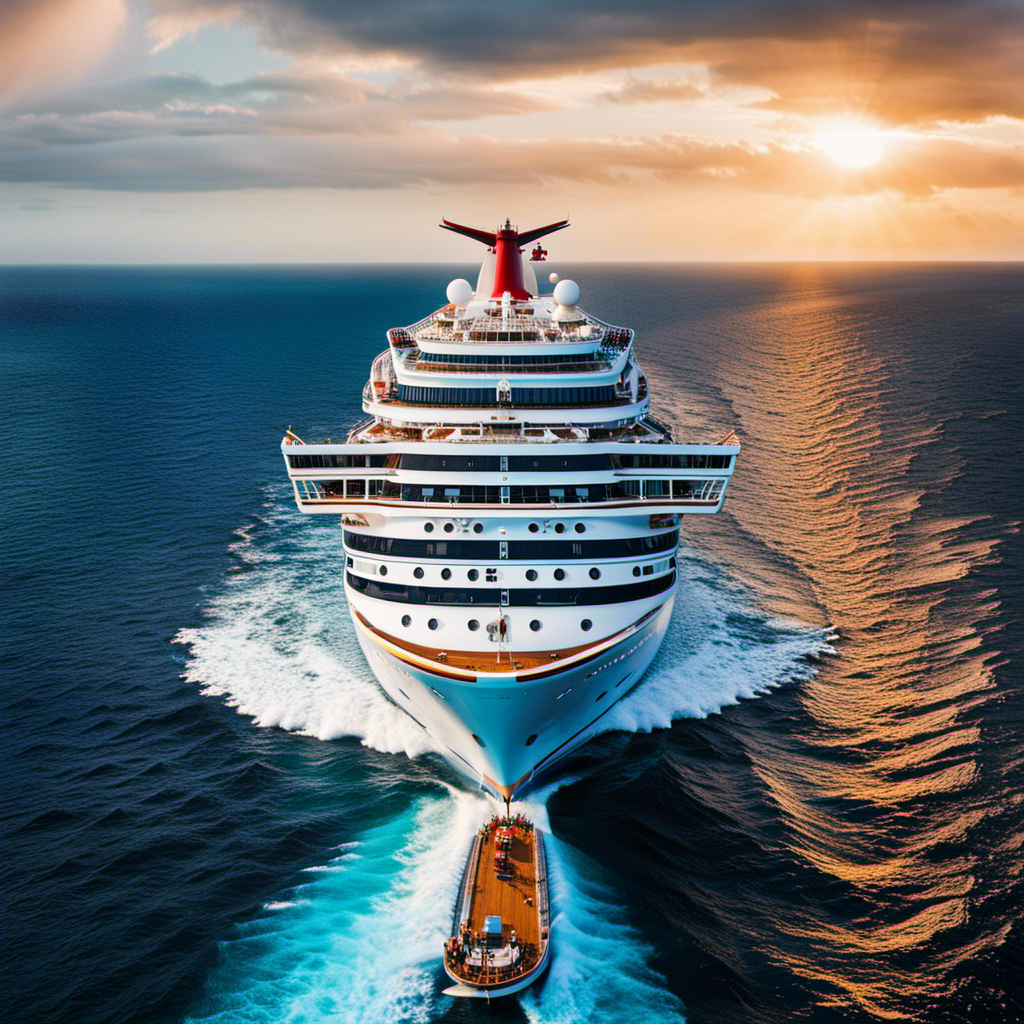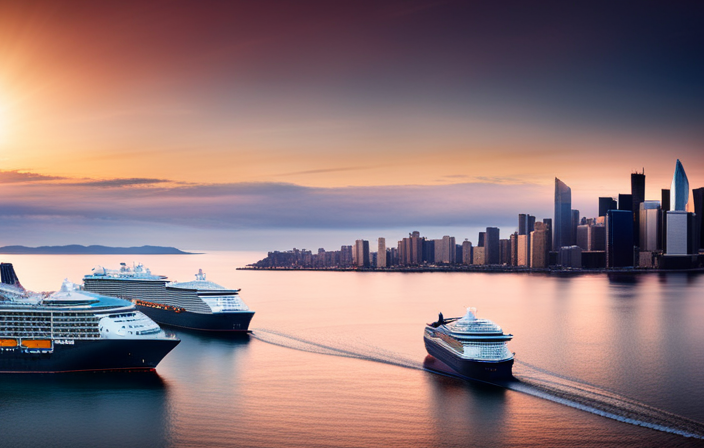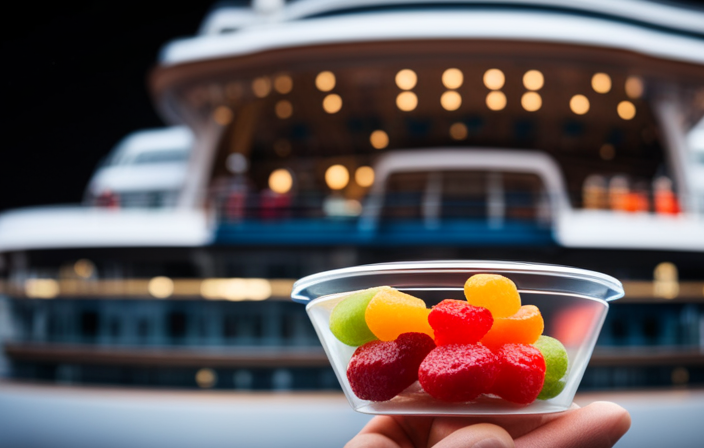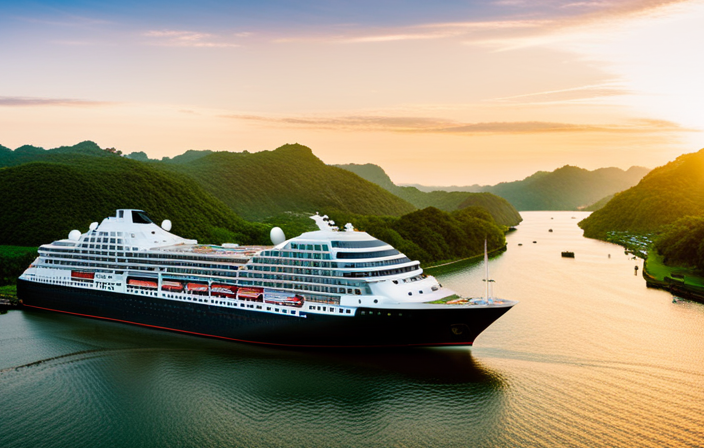Carnival Corporation is making waves in the cruise industry by expanding its strategy for selling off its fleet. In a recent announcement, the company revealed its intention to sell an additional five cruise ships, on top of the 13 ships it previously intended to sell. This approach is expected to significantly reduce operational costs and lower fuel consumption.
However, the specific ships to be sold have not been disclosed. Additionally, there have been updates on new ship deliveries, with some delays and adjustments to the original schedule.
Stay tuned for more updates on Carnival’s strategic moves in the cruise market.
Key Takeaways
- Carnival Corporation has announced the sale of five additional cruise ships, in addition to the 13 ships previously announced for sale.
- The sale of less efficient ships will result in operating expense efficiencies of approximately 2% per available lower berth day (ALBD) and reduce fuel consumption by approximately 1% per ALBD.
- The specific ships to be sold among the five new ships have not been disclosed, but the company plans to sell the ships that were already scheduled for future sales.
- There have been updates on new ship deliveries, with only two out of the four ships originally scheduled for delivery in 2020 to be delivered before the end of fiscal 2020, and only five out of the nine ships originally scheduled for delivery in fiscal 2020 and 2021 to be delivered before the end of fiscal year 2021.
Carnival’s Ship Sale Announcement
Carnival Corporation has announced the sale of five additional cruise ships. This is in addition to the 13 ships that were previously announced for sale. The sale of these ships is part of the company’s strategy to optimize its fleet and improve overall operational performance. By selling less efficient ships, Carnival expects to achieve cost savings and enhance fuel efficiency. It is estimated that the company will achieve approximately 2% cost savings per available lower berth day (ALBD) and 1% fuel efficiency improvement per ALBD.
The decision to divest these ships aligns with Carnival Corporation’s future ship orders and reflects its commitment to adapting to the evolving dynamics of the cruise industry. As the company continues to navigate through challenges, this move demonstrates its proactive approach in streamlining operations and maximizing profitability. This announcement highlights the company’s focus on operating expense efficiencies and reduced fuel consumption.
Uncertainty Regarding Ships to be Sold
I’m unsure which ships will be sold out of the five new ones as Carnival Corporation did not disclose this information in their announcement. However, we can speculate on potential implications and discuss which ships are most likely to be sold based on certain factors.
-
The sale of these ships will inevitably reduce the size of Carnival’s fleet, which could impact their market position. With fewer ships available, they may have to adjust their offerings for customers.
-
When considering which ships are most likely to be sold, factors such as age, size, and profitability come into play. Older ships or those that are less profitable may be more likely candidates for sale. Carnival might also consider selling ships that were already scheduled for future sales.
These are just some potential discussion ideas, but without further information from Carnival, it is difficult to determine the specific ships that will be sold.
Updates on New Ship Deliveries
Only two out of the four ships originally scheduled for delivery in 2020 will be delivered before the end of fiscal 2020. This delay in new ship construction will have a significant impact on the cruise industry.
As Carnival Corporation struggles to navigate the challenges posed by the COVID-19 pandemic, the delayed delivery of these ships further hinders their ability to recover. The cruise industry heavily relies on the introduction of new ships to attract customers and maintain competitiveness. With fewer ships being delivered, Carnival Corporation may face difficulties in meeting the demand for cruises once travel restrictions are lifted.
Additionally, the delayed delivery of these ships may also affect the company’s financial performance, as the revenue generated from new ship launches is a crucial driver of profitability.
Overall, the updates on new ship deliveries highlight the ongoing challenges faced by Carnival Corporation and the broader cruise industry.
Operating Expense Efficiencies
As I step onto the deck of a cruise ship, I can feel the hum of efficiency pulsating through the vessel, like a well-oiled machine smoothly navigating the open sea. Carnival Corporation’s sale of less efficient ships is expected to have a significant impact on its financial performance.
The sale of these ships will result in operating expense efficiencies of approximately 2% per available lower berth day (ALBD), reducing fuel consumption by approximately 1% per ALBD. These cost savings will contribute to Carnival’s overall financial performance and help streamline its operations.
Additionally, the announcement of the ship sales has generated interest from potential buyers. While Carnival has not disclosed which of the five new ships will be sold, the company plans to sell the ships that were already scheduled for future sales. This demonstrates the market’s interest in acquiring Carnival’s ships and highlights the potential value of these assets.
Fuel Consumption Reduction
The reduction in fuel consumption is expected to positively impact Carnival’s financial performance. By reducing fuel consumption by approximately 1% per available lower berth day (ALBD), Carnival will not only save on fuel costs but also improve its environmental sustainability.
The decrease in fuel consumption will contribute to a more efficient operation, resulting in lower operating expenses for the company. This reduction in expenses will have a positive financial implication for Carnival, as it will increase profitability and overall financial performance.
Moreover, the decrease in fuel consumption aligns with the company’s commitment to environmental sustainability, as it helps to reduce carbon emissions and minimize the environmental impact of its operations.
Ultimately, this fuel consumption reduction demonstrates Carnival’s dedication to both financial success and environmental responsibility.
Related Articles about Carnival Cruise
I enjoyed reading various articles about Carnival Cruise and learning more about their offerings and experiences. Here are four key points that stood out to me:
-
Cruise ship industry trends: The articles discussed the latest trends in the cruise ship industry, such as the growing popularity of smaller expedition ships and the demand for unique and immersive experiences.
-
Impact of ship sales on Carnival’s financial performance: The sale of additional cruise ships by Carnival Corporation is expected to result in operational and fuel consumption efficiencies. These cost savings will likely have a positive impact on Carnival’s financial performance and help improve their bottom line.
-
Carnival’s oldest ship: One article shared a personal experience of taking a cruise on Carnival’s oldest ship. The author regretted their decision, highlighting the importance of choosing a newer ship for a more enjoyable experience.
-
Comparison with Royal Caribbean: There were several articles that compared Carnival Cruise with Royal Caribbean. These comparisons focused on various aspects such as accommodations, family-friendly amenities, onboard activities, dining options, and entertainment. These articles provided valuable insights for travelers looking to choose between the two cruise lines.
Overall, these articles provided a comprehensive view of Carnival Cruise and its position in the cruise ship industry, highlighting industry trends and the potential impact of ship sales on Carnival’s financial performance.
Comparing Carnival and Royal Caribbean
Moving on from discussing related articles about Carnival Cruise, let’s now delve into a comparison between Carnival and Royal Caribbean.
When it comes to onboard activities and dining options, these two cruise lines offer an array of choices to cater to different preferences.
Carnival Cruise Line is known for its vibrant and lively atmosphere, offering a variety of activities for all ages. From thrilling water slides and high-energy deck parties to comedy shows and live music performances, there is never a dull moment onboard a Carnival ship.
On the other hand, Royal Caribbean prides itself on providing innovative and adrenaline-pumping activities. With features like rock climbing walls, surf simulators, and even skydiving simulators, Royal Caribbean aims to create unforgettable experiences for its guests.
In terms of dining options, both cruise lines offer a wide range of choices to satisfy every taste bud. Carnival Cruise Line offers diverse culinary experiences, from casual buffet-style dining to specialty restaurants serving international cuisines. Similarly, Royal Caribbean offers a variety of dining venues, including fine dining options, casual eateries, and even themed restaurants.
Overall, both Carnival and Royal Caribbean excel in providing a plethora of onboard activities and dining options, ensuring that guests have a memorable and satisfying cruise experience.
Fortunately, I was able to experience the vibrant atmosphere and thrilling activities offered by both Carnival and Royal Caribbean during my recent cruise. When comparing the two cruise lines, I found that Carnival offers a wide range of onboard activities, including water parks, casinos, and live entertainment. On the other hand, Royal Caribbean stands out with its innovative features such as skydiving simulators and robotic bartenders.
To provide a visual representation of the comparison, here is a table showcasing some key aspects of both cruise lines:
| Carnival | Royal Caribbean |
|---|---|
| Water parks | Skydiving simulators |
| Casinos | Robotic bartenders |
| Live entertainment | Innovative features |
Now, let’s shift our focus to the financial impact of Carnival’s ship sales. With the sale of additional cruise ships, Carnival expects to achieve operating expense efficiencies of approximately 2% per available lower berth day (ALBD) and reduce fuel consumption by approximately 1% per ALBD. This strategic move aims to improve the company’s financial performance by eliminating less efficient ships from its fleet. Additionally, it is worth noting the impact of these ship sales on cruise itineraries. Carnival plans to sell the ships that were already scheduled for future sales, which may result in adjustments to planned routes and destinations for future cruises.
Frequently Asked Questions
How many cruise ships has Carnival Corporation previously announced for sale?
Carnival Corporation previously announced the sale of 13 cruise ships. This will have a significant impact on the cruise industry, as it will result in operating expense efficiencies of approximately 2% per available lower berth day and a reduction in fuel consumption by approximately 1% per available lower berth day.
Which ships are included in the five additional cruise ships that Carnival Corporation plans to sell?
Carnival Corporation has not disclosed which specific ships are included in the five additional cruise ships they plan to sell. However, they have mentioned that the ships to be sold are those already scheduled for future sales.
When will the two out of the four ships originally scheduled for delivery in 2020 be delivered?
The two out of four ships originally scheduled for delivery in 2020 will be delivered before the end of fiscal 2020. The delay in ship delivery may impact Carnival Corporation’s financial performance due to potential revenue loss.
How many out of the nine ships originally scheduled for delivery in fiscal 2020 and 2021 will be delivered before the end of fiscal year 2021?
Out of the nine ships originally scheduled for delivery in fiscal 2020 and 2021, only five will be delivered before the end of fiscal year 2021. This could have potential implications on the cruise industry’s growth and revenue projections.
How many cruise ships and smaller expedition ships are expected to be delivered by the end of fiscal year 2022 out of the 13 originally scheduled for delivery?
Out of the 13 cruise ships originally scheduled for delivery by the end of fiscal year 2022, it is expected that nine cruise ships and two smaller expedition ships will be delivered by then. This delay may impact Carnival Corporation’s financial outlook. In comparison to other major cruise companies, Carnival Corporation’s ship delivery schedule is slightly behind.
Meet Asra, a talented and adventurous writer who infuses her passion for exploration into every word she writes. Asra’s love for storytelling and her insatiable curiosity about the world make her an invaluable asset to the Voyager Info team.
From a young age, Asra was drawn to the power of words and their ability to transport readers to far-off lands and magical realms. Her fascination with travel and cultures from around the globe fueled her desire to become a travel writer, and she set out on a journey to turn her dreams into reality.











